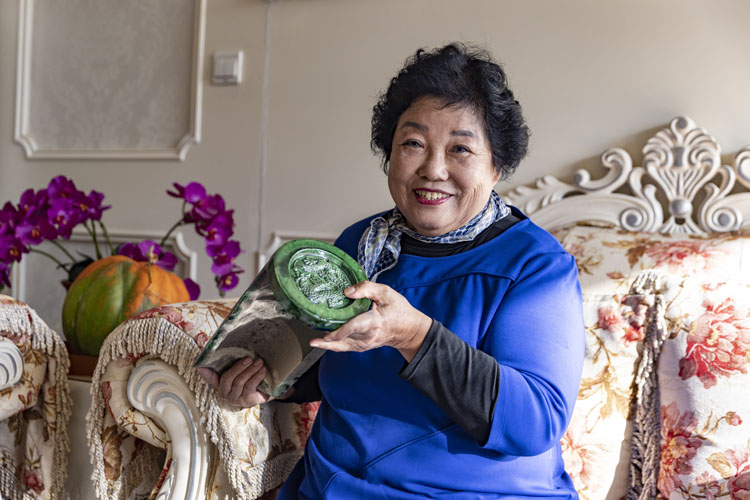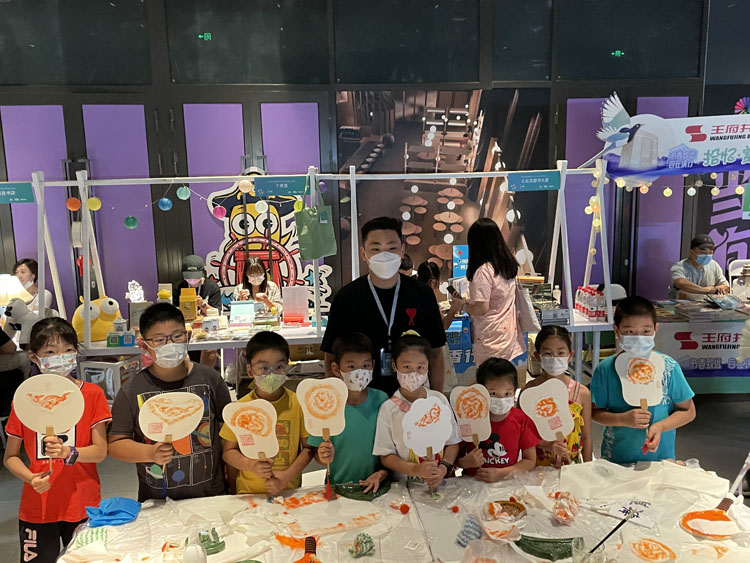A Glazed Life

Ji Ruiqin displays a piece of glazed tile made by Anhe Glazed Tile Company, November 16, 2022.
"Now Born in 1951, Ji Ruiqin is a native of Beijing. When she was young, she did many kinds of jobs and made the “first bucket of gold,” which helped her and her husband launch Anhe Glazed Tile Company in the 1980s. After starting firing glazed tiles at the age of 35, she has been working with them for half her life.
Seven Days and Nights
“You probably wouldn’t believe I once stayed awake for seven days and seven nights straight,” Ji said.
Things were not smooth at first. A bank loan of 45,000 yuan (about US$6,400) financed construction of two small kilns, but the quality of the products was not great.
“Large trucks transported the tiles to the construction site, and an inspector grabbed one to sample,” Ji recalled. “He stepped on it, and the tile broke into pieces.” Her company secured a large contract to produce green glazed tiles for the Jade Palace Hotel in Beijing, but her products were rejected. “If they broke so easily just by stepping on it, how could you put them on a roof?”
That day, trucks returned the same way, and the whole load of glazed tiles was dumped at a waste yard. This caused a loss of more than 40,000 yuan (about US$5,700), leaving Ji Ruiqin considering closing the factory.
“What would I do with the money owed to the bank if I closed the factory?” Ji said to herself. “My family had only a dilapidated house. Nothing could be mortgaged to pay off the loan. Our only way out was to make a determined effort to try again.” So, she decided to hang on.
To improve the quality of glazed tiles, Ji made every effort and repeatedly tried different material ratios. She stayed at the factory without eating or sleeping for seven days and nights. When she finally produced a satisfactory glazed tile, she collapsed on the floor and fell asleep. “It’s quite warm right outside the kiln, so I slept well there.”
“I put my whole life on it.” Working in the kiln all year round, Ji Ruiqin suffered many injuries. She has a burn scar as large as two palms on her right leg. Her hands are blackened due to long-term exposure to pigment containing copper. One of her fingers was deformed from sawing. Moving so many heavy objects led to lower back injuries, and she now has steel plates and nails in her lower back.
The Light of Glazed Tiles
During the Ming (1368-1644) and Qing (1644-1911) dynasties, glazed tiles represented hierarchical status. Strict regulations governed the usage and production of glazed tile components, and ordinary people were not allowed to use them without authorization. Glazed tiles of different colors symbolized different social classes. For example, in the Forbidden City, also known as the Palace Museum, the colors of the roofs of the buildings were determined according to the theory of the Five Elements of metal, wood, water, fire, and earth in ancient China. The color yellow was exclusive to the emperor and the crown prince. Yellow stands for earth, showing that the emperor was in the middle and ruled all, while other princes lived in palaces with roofs covered with green glazed tiles. Green belongs to the east and stands for wood, so it represents growth and symbolizes vitality. Black represents water and can overcome fire, so black glazed tiles were used on the roof of the ancient fire brigade of the Forbidden City.

At a cultural activity in Beijing during the 2022 Mid-Autumn Festival, Wang Zi, founder of Anhe Construction and a third-generation inheritor of Anhe glazed tile making technique, instructs children to rub the patterns on tile rubbings onto fans.
In 2003, reconstruction began on the Palace of Established Happiness in the Forbidden City. After visiting glazed tile manufacturers in Beijing, Shandong Province, and other places, the contractors ultimately chose Anhe. During production, Ji Ruiqin worked with Piao Xuelin, a senior consultant of ancient architecture of the Forbidden City. Mr. Piao is the 15th-generation inheritor of the tile producer Xinglongmen, and Ji received a wealth of guidance from him.
“A single window frame of a building in the garden of the Palace of Established Happiness may involve more than 20 kinds of glazed tiles, and Mr. Piao was familiar with all of them.” Ji admired his erudition. “He also knew what kind of tiles were used in every corner of the Forbidden City.”
It took three years to rebuild the Palace of Established Happiness. After the project was completed, Zheng Xinmiao, then director of the Palace Museum, sent Ji Ruiqin a horizontal board inscribed with four Chinese characters meaning “the light of glazed tiles.”
Years ago, the courtyard wall of the Hall of Prayer for Good Harvests in the Temple of Heaven had fallen into disrepair, and some green glazed tiles needed to be replaced. The department in charge invited three manufacturers to submit samples, and its chief inspected their products personally. Of the 265 pieces Anhe first made, only five were qualified, and the rest were put on the truck and sent back.
After returning home, Ji Ruiqin inspected what set the approved tiles from the rest. Those she deemed qualified were glazed, and the unqualified ones were all thrown away. Anhe won the project over three other bidders. Anhe tiles were improving constantly and winning trust from more and more cultural relic sites. Now, nine of the 14 heritage sites on Beijing’s Central Axis including the Yongding Gate, the Temple of Heaven, and the Forbidden City have used glazed tiles produced by Ji’s factory.
Making glazed tiles for more than 30 years brought Ji Ruiqin to cities and temples all over the country. Glazed tiles in different regions have various styles and patterns. They vary not only in raw material and glaze, but also in craftsmanship and style. “The glazed tiles we produce are all in strict accordance with the styles of each dynasty, and any deviation isn’t allowed, no matter how slight it may be. Since we are engaged in this profession, we must build good glazed tiles for ancient buildings, and carry forward the craftsmanship of our ancestors.”
“The Central Axis is the backbone of Beijing,” Ji Ruiqin illustrated. “This backbone ensures the body is healthy. Without it, the body would either be crooked or collapse.”